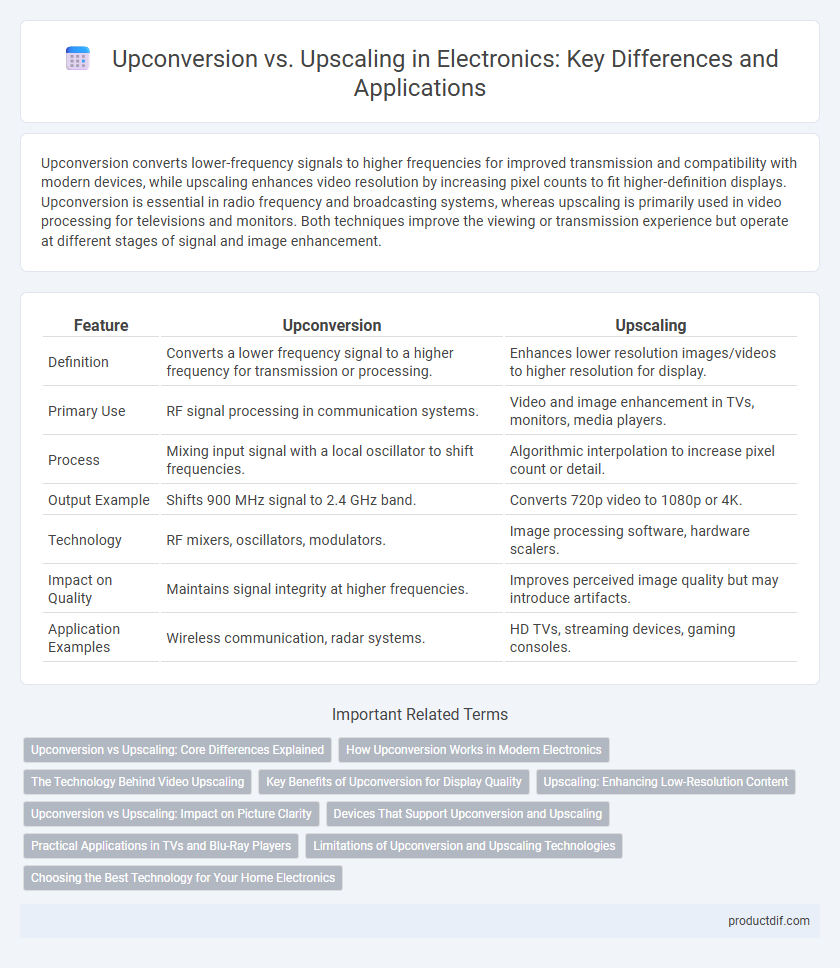Upconversion converts lower-frequency signals to higher frequencies for improved transmission and compatibility with modern devices, while upscaling enhances video resolution by increasing pixel counts to fit higher-definition displays. Upconversion is essential in radio frequency and broadcasting systems, whereas upscaling is primarily used in video processing for televisions and monitors. Both techniques improve the viewing or transmission experience but operate at different stages of signal and image enhancement.
Table of Comparison
| Feature | Upconversion | Upscaling |
|---|---|---|
| Definition | Converts a lower frequency signal to a higher frequency for transmission or processing. | Enhances lower resolution images/videos to higher resolution for display. |
| Primary Use | RF signal processing in communication systems. | Video and image enhancement in TVs, monitors, media players. |
| Process | Mixing input signal with a local oscillator to shift frequencies. | Algorithmic interpolation to increase pixel count or detail. |
| Output Example | Shifts 900 MHz signal to 2.4 GHz band. | Converts 720p video to 1080p or 4K. |
| Technology | RF mixers, oscillators, modulators. | Image processing software, hardware scalers. |
| Impact on Quality | Maintains signal integrity at higher frequencies. | Improves perceived image quality but may introduce artifacts. |
| Application Examples | Wireless communication, radar systems. | HD TVs, streaming devices, gaming consoles. |
Upconversion vs Upscaling: Core Differences Explained
Upconversion transforms lower-frequency signals into higher-frequency signals, enhancing compatibility with modern digital devices, while upscaling increases the resolution of a video image to match higher display standards. Upconversion deals primarily with signal format and frequency, often used in audio and video transmission to move from analog to digital or from SD to HD signals. Upscaling, on the other hand, focuses on improving perceived image quality by interpolating additional pixels, commonly applied in TV and monitor displays to convert lower-resolution content to higher resolutions like 4K or 8K.
How Upconversion Works in Modern Electronics
Upconversion in modern electronics involves converting lower-frequency signals, such as baseband or intermediate frequencies, to higher-frequency signals suitable for transmission or processing by RF components. This process uses mixers, oscillators, and filters to shift signal frequencies while maintaining signal integrity for applications like wireless communication and broadcasting. Upconversion enhances signal clarity and bandwidth efficiency by enabling devices to operate within designated frequency bands.
The Technology Behind Video Upscaling
Video upscaling technology relies on algorithms that increase the resolution of lower-quality footage by interpolating additional pixels, enhancing image sharpness and detail. Upconversion, distinct from upscaling, involves converting analog signals to digital formats, enabling compatibility with modern displays while preserving signal integrity. Advanced video processors use machine learning techniques to refine upscaling by predicting and reconstructing high-resolution details for a more natural and immersive viewing experience.
Key Benefits of Upconversion for Display Quality
Upconversion enhances display quality by converting lower-resolution content into higher-resolution signals, preserving image clarity and detail for modern screens like 4K and 8K TVs. It improves color accuracy and contrast through advanced processing algorithms, resulting in more vibrant and lifelike visuals compared to traditional upscaling methods. Key benefits include reduced pixelation, smoother edges, and enhanced texture representation, making upconversion essential for optimizing viewing experiences on high-definition displays.
Upscaling: Enhancing Low-Resolution Content
Upscaling enhances low-resolution content by increasing pixel count to fit higher-resolution displays, improving image clarity without changing the original data. Advanced upscaling algorithms utilize machine learning and edge enhancement techniques to minimize artifacts like blurriness and jagged edges, delivering sharper visuals on 4K and 8K screens. Upscaling is crucial for streaming services and gaming consoles, enabling older or lower-quality videos to appear more detailed on modern high-definition TVs.
Upconversion vs Upscaling: Impact on Picture Clarity
Upconversion improves picture clarity by converting lower-resolution video signals to higher resolutions through advanced algorithms that enhance detail and reduce noise, resulting in sharper and more vibrant images. Upscaling, on the other hand, enlarges the image to fit higher-resolution screens but often relies on basic pixel interpolation, which can lead to softness and less defined edges. Understanding the distinction between upconversion's true signal enhancement and upscaling's pixel stretching is crucial for achieving optimal display performance in televisions and monitors.
Devices That Support Upconversion and Upscaling
Devices that support upconversion include high-end Blu-ray players, AV receivers, and gaming consoles that convert lower resolution content to higher resolutions such as 4K UHD. Upscaling is commonly found in smart TVs, streaming devices, and media players, enhancing video signals by interpolating pixels for improved HD or 4K display quality. Advanced GPUs also perform upscaling in real-time for gaming, delivering sharper and more detailed images on high-resolution monitors.
Practical Applications in TVs and Blu-Ray Players
Upconversion enhances lower-resolution video signals to high-definition or 4K quality by converting the signal's frequency, commonly used in Blu-Ray players to improve image clarity on HDTVs. Upscaling digitally increases the resolution of standard or HD content to match the native resolution of modern TVs, often implemented within television sets for smoother visuals. Both technologies optimize viewing experiences, with upconversion focusing on signal enhancement and upscaling targeting resolution adjustment.
Limitations of Upconversion and Upscaling Technologies
Upconversion technology is limited by its dependence on original signal quality, often resulting in artifacts and reduced clarity when enhancing lower-resolution content. Upscaling methods struggle with pixel interpolation, leading to blurry edges and loss of fine details, especially on large high-definition displays. Both techniques cannot fully replicate true high-resolution imagery, highlighting inherent constraints in improving visual fidelity from low-resolution sources.
Choosing the Best Technology for Your Home Electronics
Upconversion converts lower-resolution video signals into higher resolutions by interpreting and enhancing the original data, ideal for devices like DVD players and older gaming consoles. Upscaling, often used in modern TVs, digitally stretches existing pixels to fill larger screens but may introduce artifacts or reduced clarity compared to true upconversion. For home electronics, selecting upconversion ensures better image quality and compatibility with diverse content sources, making it the preferred choice for maintaining visual fidelity.
Upconversion vs Upscaling Infographic

 productdif.com
productdif.com